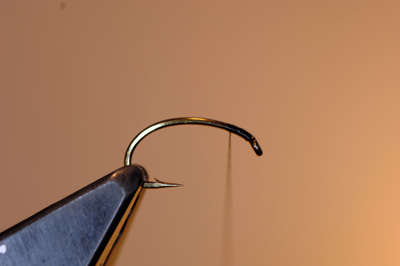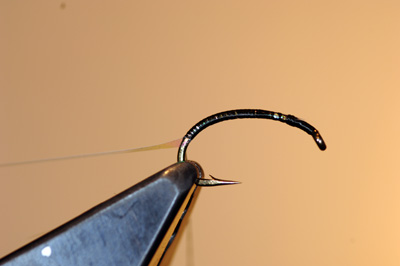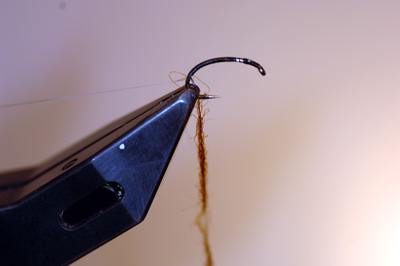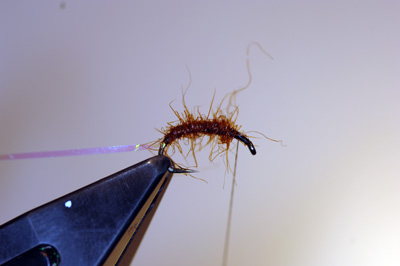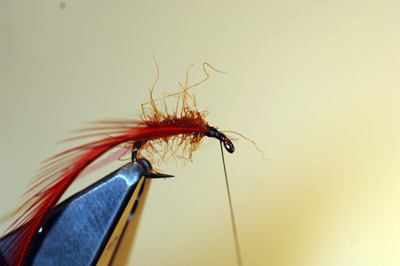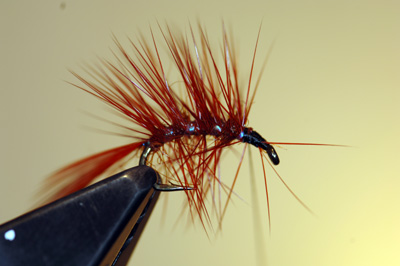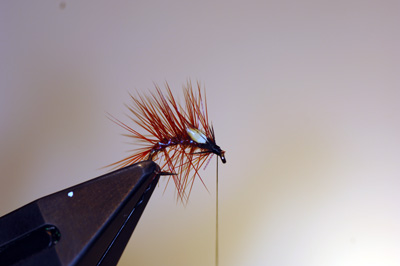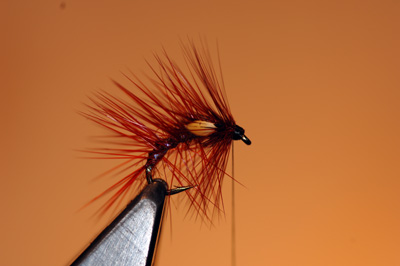
Snatcher Wet Fly
This is one of the modern still water patterns that were born on the lochs of Scotland. As with many modern patterns it can be utilised to represent many emerging naturals or alternatively it can be tied with bright and shiny materials that attract those aggressive rainbows.
It was however designed as an emerging buzzer pattern and was effectively an improved Bibio.
The example here is of a fiery brown snatcher. If you want a more attracting pattern swap the body materials from seals fur to gold or silver mylar.
- Hook: Kamasan B100 or any curved shaped hook (not too heavy).
- Silk: To match the fly (I have used black silk so it can be seen)
- Rib: Pearl mylar or Gold or silver wire or oval
- Body Hackle: Palmered fiery brown saddle feather from head to tail
- Cheeks: Small Jungle fowl feathers.
- Collar Hackle: Fiery brown cock hackle
Firstly attach silk to the hook shank by way of a jam knot.
Now attach the ribbing material and wind down the silk past the bend of the hook trapping in the rib underneath the shank of the fly.
If you want an exposed tag of pearl or other flashy material then add the ribbing material after forming the tag.
Now attach the dubbing to the silk thread.
Some tiers find this difficult and fiddley so here are a couple of tips.
If the material you are using will not bind together rub it in the palm of your hand for a few moments. This will cause it to soften and you will be able to manipulate it easier.
Another tip is to wet your thumb and forefinger with a little spittle and then rub it dry by rubbing thumb and forefinger together. You will feel the pads of those fingers become more adhesive.
Now place the material to be dubbed on the forefinger and place the tying silk on top of it. Then put your thumb on top of that and roll the material onto the thread. It is important only to roll the material one way.
This will allow the dubbing to attach itself to the thread. Then continue to dub the fur on by the same rolling motion along the length of the silk. If you build up a lump then tease it apart with your thumbnail and then roll it again.
Do not put too much dubbing on to start. You can always add more. It is the dubbing that gives the fly an overall colour and it needs some light to shine through it.
Now wind the dubbing on to the shank in touching turns but stop short by 3 to 4 mm from the head as this is where we tie in the saddle hackle to Palmer down the body.
Attach the saddle hackle on the shank by the butt or lower stem with the good or convex side facing the head. I tie the butt or stem in with a figure of eight wind and then part of the stem to the shank. This will ensure that when you pull the saddle tight to wind it down the shank it will not pull free of the tying in point.
Wind down the hackle in open turns to the rear of the fly and then secure it with a turn of the ribbing material.
The palmered hackle should be wound on clockwise and the rib in the same direction. This will allow the rib to trap the stem of the saddle hackle to the hook shank and so ensure added strength to the fly.
Tie in the rib and remove the waste hackle and the rib.
Select two evenly matched small Jungle cock eye feathers and remove the soft flue feathers from the stem and tie them in as wing buds or cheeks. Remember however that they do not want to come back any further than the point of the hook.
If you have a large eye feather then you can split it by first sticking it with a pin or dubbing needle in the centre of the feather and then pull back on the stem dragging the eye part of the feather through the needle.
Now take a fiery brown cock hackle and double it back and tie it in front of the jungle cock feathers by the tips and form the collar. Tie off and from the head.
Whip finish and varnish the head.
If you have any questions or need help then just go through the forum.
Good fishing.


